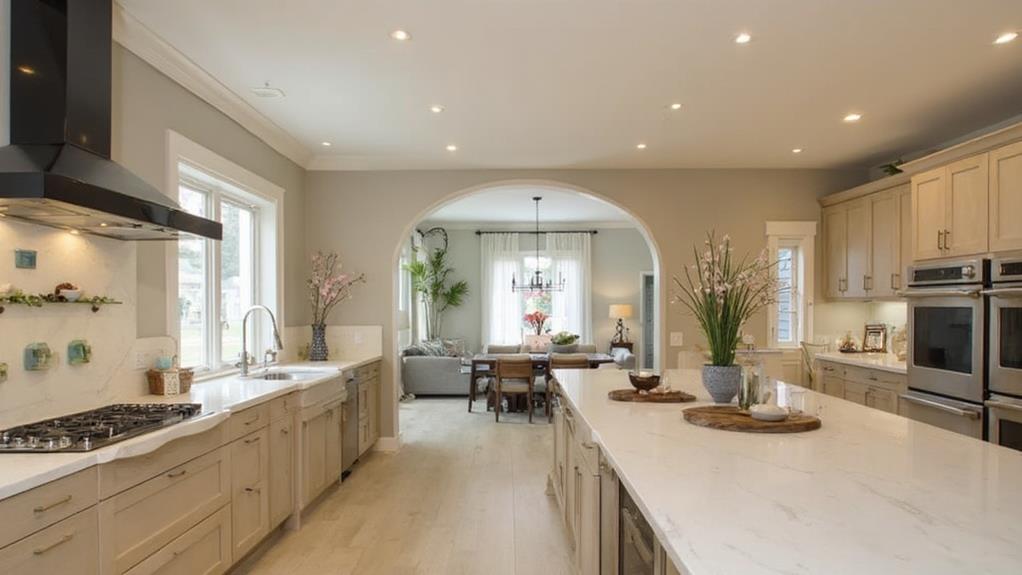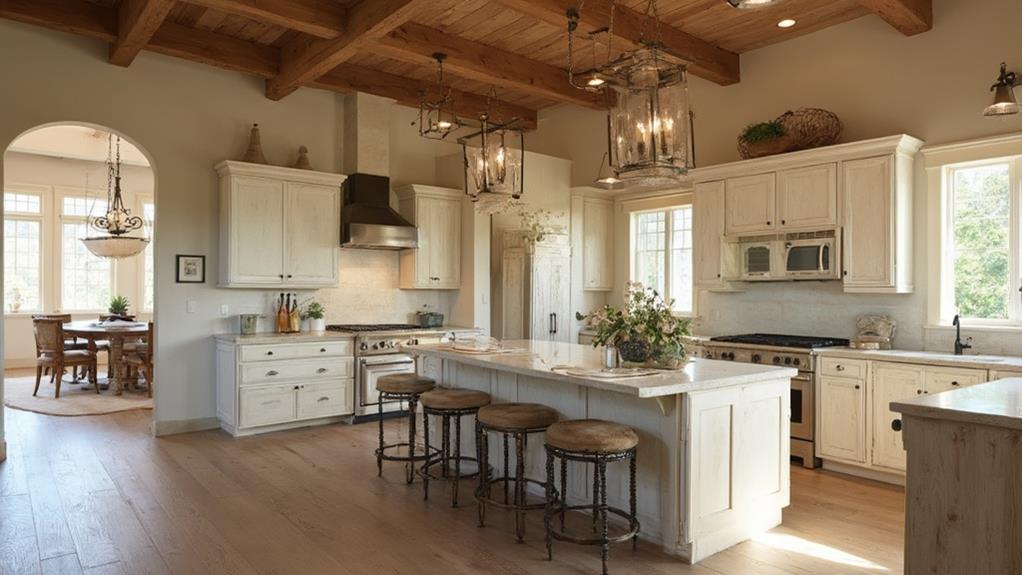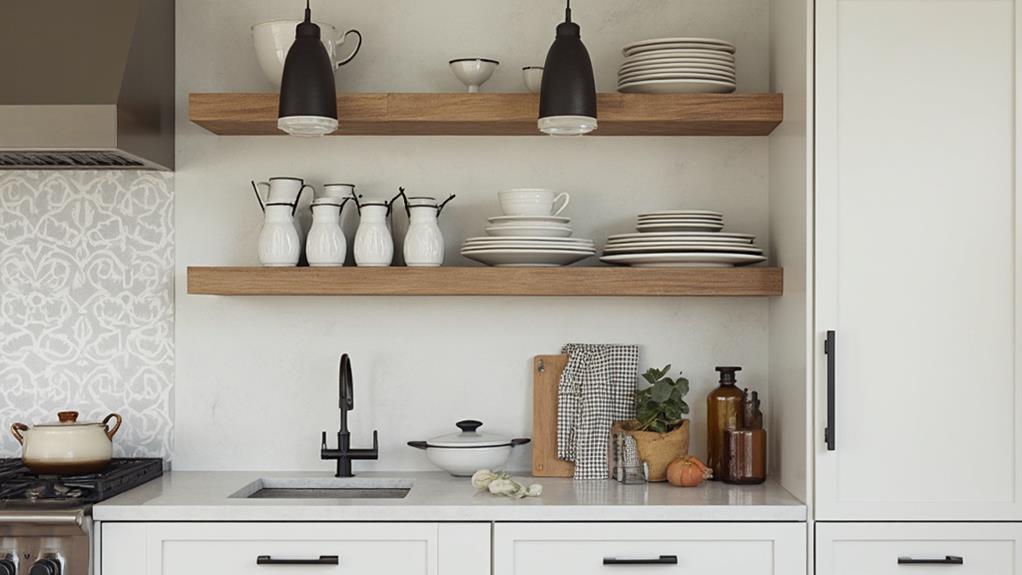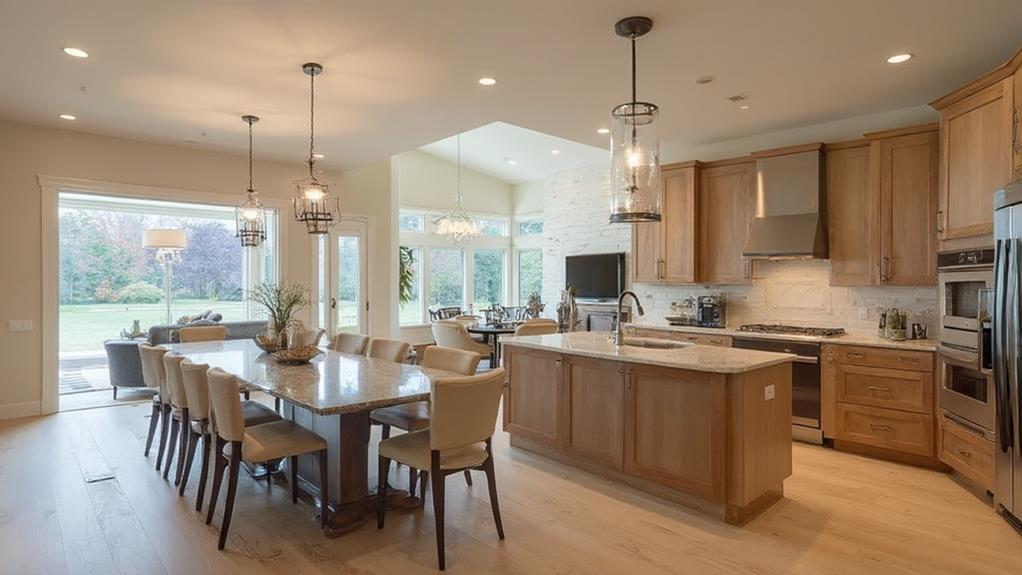To create a cohesive look, match your kitchen to your home's style by focusing on color coordination, material consistency, and architectural flow. Use a 60-30-10 rule for color distribution and select materials that complement your home's overall aesthetic. Align architectural elements like ceiling heights and window styles with adjacent rooms, and choose lighting fixtures that harmonize with your home's design. Pay attention to accessories, from small appliances to wall art, ensuring they reflect your home's style. By carefully considering these elements, you'll create a kitchen that seamlessly integrates with your home's look and feel. The devil is in the details when it comes to achieving true cohesion.
Color Coordination Strategies

Color is the cornerstone of kitchen design. When matching your kitchen to your home's style, it's crucial to develop a cohesive color palette. Start by identifying the dominant colors in adjacent rooms and throughout your house. Choose a primary color for your kitchen that complements these existing hues.
Consider using a 60-30-10 rule for color distribution: 60% for the dominant color, 30% for a secondary color, and 10% for an accent color. Apply these colors to various elements like walls, cabinets, countertops, and backsplashes. For a harmonious look, select colors from the same family or use complementary shades.
Don't forget about neutrals. They can serve as a unifying element across different spaces. White, beige, or gray can create a versatile backdrop for bolder accent colors. If you're aiming for a more dramatic look, consider using contrasting colors strategically.
Remember that lighting plays a significant role in how colors appear. Test your chosen colors under different lighting conditions before committing. Lastly, consider the mood you want to create. Warm colors like reds and yellows can energize the space, while cool blues and greens promote relaxation.
Material Selection and Consistency
Beyond color choices, the materials you select for your kitchen play a key role in matching it to your home's style. Consider the overall aesthetic of your house when choosing countertops, cabinets, flooring, and backsplashes. For a modern home, opt for sleek materials like stainless steel, glass, or polished concrete. Traditional homes pair well with natural stone, wood, and ceramic tiles.
Ensure consistency in material finishes throughout your kitchen and adjacent spaces. If you've used brushed nickel hardware in your living room, carry that theme into your kitchen for a cohesive look. Don't forget about textures; smooth surfaces complement contemporary designs, while rustic or textured materials suit farmhouse or cottage styles.
Pay attention to the quality and durability of materials, as they'll impact both aesthetics and functionality. High-quality materials not only look better but also withstand daily use. If you're mixing materials, limit your selection to two or three main types to avoid a cluttered appearance. Remember, the goal is to create a kitchen that flows seamlessly with the rest of your home, reflecting your personal style while maintaining a unified design theme.
Architectural Elements and Flow

Architectural elements play a crucial role in tying your kitchen to the rest of your home. Consider incorporating features that echo the overall style of your house, such as arched doorways in a Mediterranean-inspired home or exposed beams in a rustic setting. Pay attention to ceiling heights and window styles, ensuring they align with those in adjacent rooms. This continuity creates a seamless flow between spaces.
Don't overlook the importance of flooring in creating a cohesive look. If possible, extend the same flooring material from surrounding areas into the kitchen. If that's not feasible, choose a complementary option that doesn't clash with nearby spaces. Consider how your kitchen's layout affects traffic flow throughout your home. Open floor plans require careful consideration of sight lines and transitions between areas.
Lighting fixtures can also serve as architectural elements. Select styles that complement both your kitchen's design and the overall home aesthetic. Finally, consider incorporating architectural details like crown molding, wainscoting, or built-in cabinetry that match the craftsmanship and period of your home. These elements will help your kitchen feel like an integral part of the house rather than a standalone space.
Lighting and Fixture Harmony
Lighting and fixtures work in tandem to create a cohesive look in your kitchen. When selecting these elements, consider your home's overall style and the mood you want to achieve. For traditional homes, opt for classic chandeliers or pendant lights with warm, soft illumination. Modern spaces benefit from sleek, minimalist fixtures with clean lines and cooler light temperatures.
Don't overlook the importance of layered lighting. Combine ambient, task, and accent lighting to enhance functionality and atmosphere. Under-cabinet lights, recessed ceiling fixtures, and strategically placed pendants can work together to illuminate your kitchen effectively.
Your choice of fixtures should complement both your lighting and overall home design. If you've got a farmhouse-style home, consider barn-inspired pendants or vintage-looking sconces. For contemporary spaces, try sleek stainless steel or glass fixtures. Remember to coordinate finishes across all elements, including faucets, cabinet hardware, and appliances.
Pay attention to scale and proportion when selecting fixtures. A large island might call for multiple pendants, while a small breakfast nook could be perfectly lit with a single statement piece. By carefully considering these factors, you'll create a harmonious kitchen that flows seamlessly with your home's style.
Accessorizing for Seamless Integration

With the right accessories, your kitchen can seamlessly blend into your home's overall style. Start by selecting small appliances that complement your kitchen's color scheme and design. For a modern look, choose sleek, stainless steel items, while vintage-inspired appliances work well in traditional spaces.
Consider your countertop accessories carefully. Opt for cutting boards, utensil holders, and spice racks that match your kitchen's aesthetic. In a rustic kitchen, wooden or woven items add warmth, while metallic or glass pieces suit contemporary designs.
Don't overlook the power of textiles. Dish towels, oven mitts, and chair cushions can tie your kitchen's look together. Choose patterns and colors that echo elements from other rooms in your home.
Wall art and decorative items play a crucial role in creating a cohesive feel. Select pieces that reflect your home's overall style, whether it's minimalist prints for a modern space or botanical illustrations for a country-inspired home.
Lastly, pay attention to your kitchen's organizational elements. Storage containers, pantry labels, and even garbage bins can contribute to a unified look when chosen thoughtfully.
Conclusion
As you've explored these strategies, you might've noticed your kitchen already embodying some of these principles. What a happy coincidence! You're well on your way to creating a cohesive look. Remember, it's all about balance and harmony. Trust your instincts and don't be afraid to experiment. With a keen eye and these tips in mind, you'll soon have a kitchen that flows seamlessly with your home's style, impressing both yourself and your guests.

